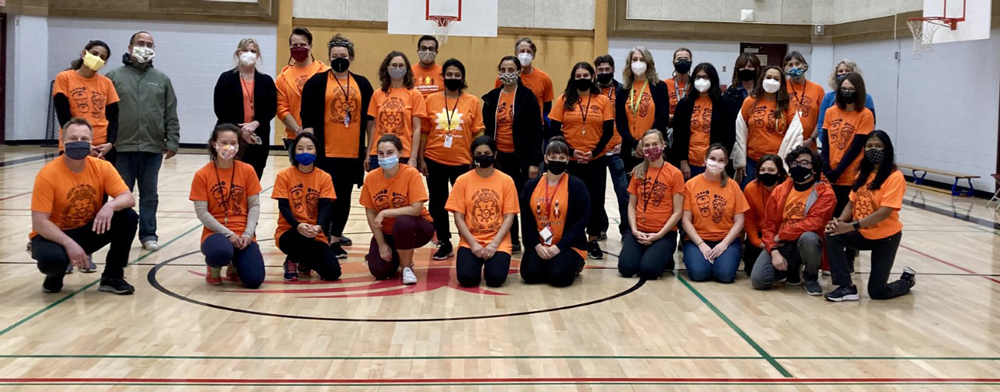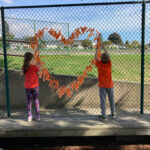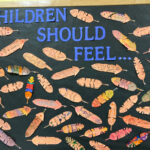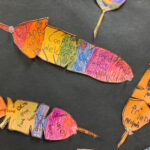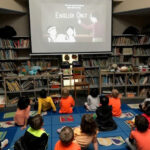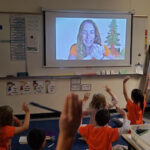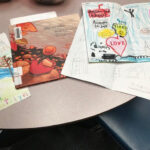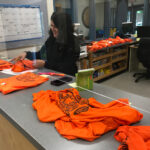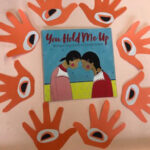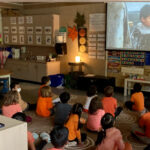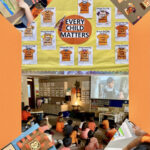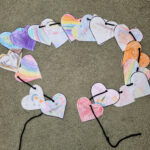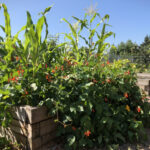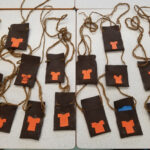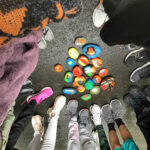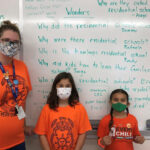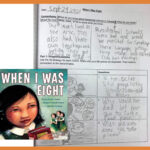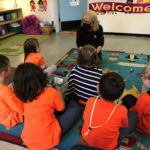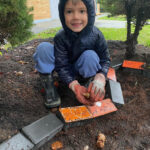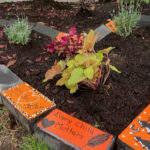Learning at the centre of Orange Shirt Week
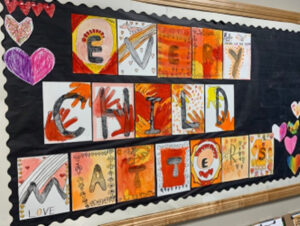
If you’re a parent or staff member at a New Westminster school, you’ve received a few emails likely about Orange Shirt Day (and what was our first Orange Shirt Week, as we work to create more substantial opportunities to honour and learn about these important issues). This also coincided with the first honouring of the National Day for Truth and Reconciliation.
It is important to have these days, weeks and even the shirts as symbols. But at the heart of those symbols needs to be learning, and in this case, unlearning.
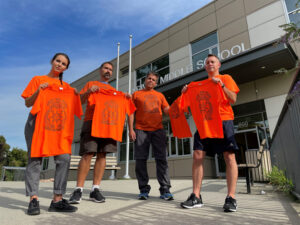 Our new District Vice-Principal for Indigenous Education had this comment to share in a recent letter of reflection and introduction she wrote: “The National Day of Truth and Reconciliation provided the opportunity for reflection on difficult truths about our country and on how we must move forward together in the best way possible.” She followed this up to say, “This year has more meaning…. and a lot more reflection on Canada’s history of colonialism and genocide of Indigenous peoples due to the finding of the 215 children, who died and were found in a mass grave burial site at Tk’emlúps te Secwépemc at the former Kamloops Indian Residential School.”
Our new District Vice-Principal for Indigenous Education had this comment to share in a recent letter of reflection and introduction she wrote: “The National Day of Truth and Reconciliation provided the opportunity for reflection on difficult truths about our country and on how we must move forward together in the best way possible.” She followed this up to say, “This year has more meaning…. and a lot more reflection on Canada’s history of colonialism and genocide of Indigenous peoples due to the finding of the 215 children, who died and were found in a mass grave burial site at Tk’emlúps te Secwépemc at the former Kamloops Indian Residential School.”
And certainly there were powerful moments that mirrored this heightened meaning at every school … as every student, staff member and others in our school communities came together around these issues.
The lessons varied across locations, classes, ages and audiences … but they touched everyone. And we wanted to give you an idea of what that looked like by sharing a sampling of content, lessons and activities from various schools.
For our staff
We can not teach what we do not know. Orange Shirt Week started with a non-instructional day that featured two very important learning opportunities for staff – organized jointly by District staff and the New Westminster Teachers’ Union.
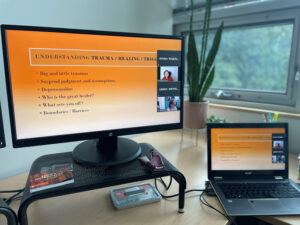 In the morning staff from both New Westminster and Surrey joined as Myrna McCallum, a local Indigenous lawyer, lead a session on “Trauma Informed Practice.” She delivered powerful lessons on trauma, on compassionate responses and on the role of cultural humility.
In the morning staff from both New Westminster and Surrey joined as Myrna McCallum, a local Indigenous lawyer, lead a session on “Trauma Informed Practice.” She delivered powerful lessons on trauma, on compassionate responses and on the role of cultural humility.
The afternoon featured an inspirational presentation from the Moose Hide Campaign … highlighting their powerful work and providing tangible ways to support positive and safe relationships for women and children.
(The Moose Hide Campaign is a grassroots movement of Indigenous and non-Indigenous men and boys who are standing up against violence towards women and children. Wearing this moose hide signifies your commitment to honour, respect, and protect the women and children in your life and to work together to end violence against women and children.)
Our elementary schools
As humans, we learn, connect and grow through story and creation. And that can be seen so clearly for our youngest learners especially.
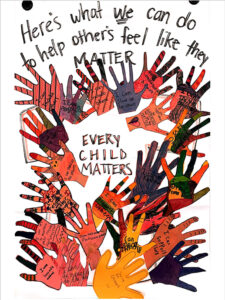 The experiences and lessons shared in age-appropriate books became teachable moments and reflections that inspired art. Stories captured in film (or the “Grandpa’s Drum” episode of Molly of Denali) captured kids into lessons that sparked conversation.
The experiences and lessons shared in age-appropriate books became teachable moments and reflections that inspired art. Stories captured in film (or the “Grandpa’s Drum” episode of Molly of Denali) captured kids into lessons that sparked conversation.
The artwork created honours the legacy of harm, but it also plants seeds of hope as our youngest learners look forward.
In the case of Connaught’s heart garden that was created by staff and students, “The heart garden stands as a reminder of the devastation that occurred,” said Principal Jennifer Scorda. “It is also a symbol of the growth that needs to happen as we move forward. We intentionally created it in a space where the whole community could see it, so that it will be a reminder to everyone. Our planted garden will always be in progress – the same way that our learning, reflection and growth will be.”
Our middle schools
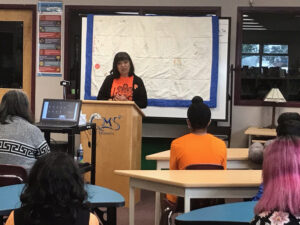
Across all our middle schools, the lessons shifted both local and to the deeper nuances of big picture policies.
The QMS team invited Chief Rhonda Larabee of the Qayqayt First Nation in to speak to speak about her Nation’s history, about Orange Shirt day, and to speak to what reconciliation means to her. The small talk happened in the library, but was broadcast out to each of the middle schools to watch. FRMS was a hub of action as Orange Shirts were sent across the District and the lessons were brought to life inside the school. And there were activities ranging from assemblies at GMS to individual class lessons that challenged kids to reflect on the 94 calls-to-action of the Truth and Reconciliation Commision.
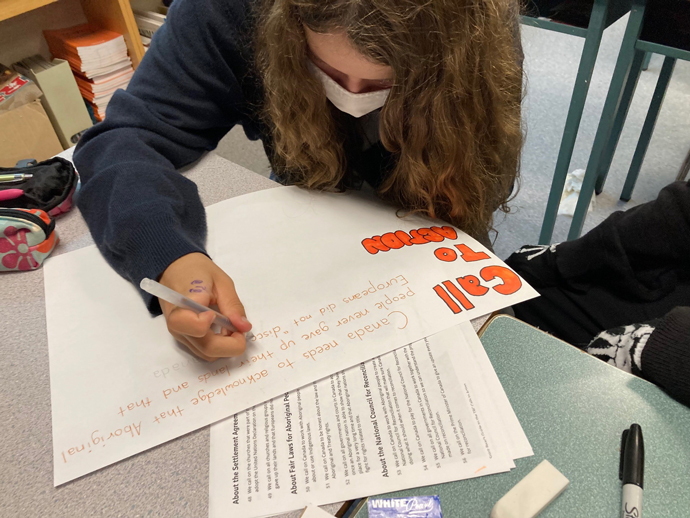
New Westminster Secondary School
When it came to NWSS, the work and lessons came in many ways, from many people:
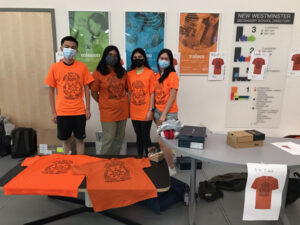
- There was an Indigenous Events Club and an Indigenous Book Club
- The Indigenous Student Leadership group sold Orange Shirts to students, organized daily announcements throughout the week, used displays to promote Indigenous authors and leaders.
- The NWSS Staff Reconciliation Committee created lessons for teachers, and curated and produced resources for easy use.
- And in a coordinated effort, the Reconciliation Committee supported and encouraged every class in block B to “take some time in the classes on Friday, October 1 to discuss the legacy of residential schools and our obligations towards building understanding, respect, and reconciliation between Indigenous and non-Indigenous people in our community and across Canada.”
All in all, it was a powerful week of learning. And while the week has come to a close, the lessons and commitment must carry on … a sentiment echoed by Connie Swan,
“As September 30th has come and gone and the wearing of orange shirts has dissipated, remember it is important now more than ever to learn about the histories of the Indigenous peoples of Canada. In order to understand the present, it is crucial to learn about the past.
Canada and BC’s colonial past should never been forgotten, like those little children. But, like any child, we are born into a world with hope and ambition. So we must learn from our past and make this a better world, a better Nation, a better province and a better community.
Education is the tool to make this happen and we will do this together and for each other. The responsibility should not rest on the shoulders of Indigenous Education Team. The responsibility is all of ours.”
